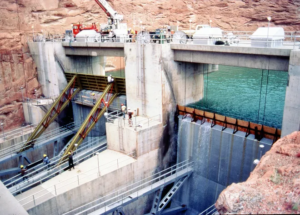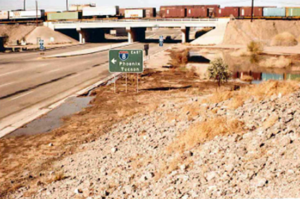Each spring, warming temperatures across the western United States signal the start of an annual transformation. Snowpack in the mountains begins to melt, and that runoff—essential to the water cycle—finds its way into rivers, creeks, storm systems, and ultimately, our communities. While this seasonal process brings opportunity and renewal, it also introduces a set of challenges that vary widely depending on location, climate, and infrastructure.
At Sunrise Engineering, we understand that spring runoff is not a one-size-fits-all issue. Our drainage engineering team works across diverse regions—from the high mountain valleys of Wyoming to the arid basins of Arizona—designing infrastructure and systems that manage stormwater and protect people, property, and natural environments.
Spring Runoff in High-Altitude Communities
In Star Valley, Wyoming, spring runoff is a relatively minor concern. According to Jason Linford, PE, most of the communities in that region are situated on higher ground. Flooding tends to be limited to river bottoms and is rarely severe enough to require large-scale interventions. That said, Jason pointed out that when temperatures rise quickly or when rain falls on existing snowpack, local streams and rivers can flood.
While large-scale drainage infrastructure isn’t prioritized in this region, development still requires drainage planning. With no city-wide storm systems available, Sunrise Engineering provides custom on-site stormwater solutions for subdivisions, schools, and commercial properties, ensuring compliance and long-term protection.
Unique Drainage Challenges in the Desert Southwest
In Arizona, spring runoff is less common—but when it happens, the effects can be significant. Ricky Holsten, PE, based in Sunrise’s Phoenix office, explained that the real challenge comes during rare, high-snowpack years or when spring storms rapidly melt mountain snow. He referenced the historic 1983 Colorado River flood as an example, when an extreme combination of snow and rain forced emergency releases from reservoirs, flooding farmland and infrastructure all the way to Yuma.


In addition to runoff from snowmelt, Arizona communities must plan for flash flooding, dry wash behavior, and unpredictable weather patterns. Sandy soils and mobile desert channels add to the complexity. Sunrise engineers use techniques like launchable riprap to manage erosion over time, allowing washes to evolve while still protecting adjacent infrastructure.
Modeling and Tools for Smarter Drainage Design
Technology plays an increasingly important role in effective stormwater design, especially in environments with complex flow behavior. FLO-2D, a two-dimensional stormwater modeling tool, has become essential in Sunrise Engineering’s Arizona drainage work. Unlike older modeling programs, FLO-2D can simulate the braided, shifting flow paths common in desert washes. Its GIS-based interface produces more accurate floodplain data and helps communities better plan for future storm events.
This modeling is often used for area drainage master plans, where public agencies and municipalities need a high-level understanding of flood behavior across large regions. The detailed mapping allows for smarter infrastructure placement, reduced flood risk, and better communication with the public.
Environmental and Regulatory Considerations
Drainage design is about more than water control—it’s about sustainability and stewardship. In Arizona, development must retain and infiltrate stormwater on-site, helping replenish groundwater and improve water quality. These retention systems reduce reliance on centralized infrastructure and align with the natural hydrologic cycle.
Regulations also shape the way drainage systems are designed. In Arizona, ephemeral washes are frequently designated as Waters of the United States, triggering additional permitting requirements under the Clean Water Act. Sunrise Engineering works with clients to navigate these regulatory pathways and design compliant, cost-effective solutions.
Funding Opportunities for Drainage Improvements
Funding for drainage projects varies by region. In Arizona, the U.S. Army Corps of Engineers offers grants for large-scale flood mitigation, while agencies like the Flood Control District of Maricopa County support smaller, community-based projects. While Star Valley doesn’t currently pursue major drainage grants, site-specific solutions remain vital to ensure responsible growth and flood prevention.
One Approach, Many Solutions
From managing unpredictable snowmelt in Wyoming to designing stormwater retention systems in Arizona subdivisions, Sunrise Engineering delivers drainage solutions tailored to each region’s needs. Our team understands the balance between water, land, infrastructure, and environment—and we bring that knowledge to every project.
Spring runoff may follow the seasons, but it doesn’t follow a script. At Sunrise, we’re prepared for that. Our engineers work with the forces of nature—predictable or not—to create systems that protect our communities and respect the land they occupy. As the snow melts and the runoff flows, we’re ready to help it find the right path.
